Dear TBR…
It seems like it was five minutes ago that THE GIVER was A Thing. And then there was UGLIES, THE PEOPLE OF EMBER, and then THE HUNGER GAMES, and then the Divergent books and THE MAZE RUNNER. Remember LIFE AS WE KNEW IT, HOW I LIVE NOW, and THE FOREST OF HANDS AND TEETH? And then, SHIPBREAKER and BLOOD RED ROAD, and a bunch of OTHER books where every other plotline revolved around having a zombie outbreak or Yellowstone blowing up and terrified teens living underground in bizarrely militaristic communes or whatnot and then the later-2010’s arrived and editors said, “The dystopia, post-apocalyptic thing is kind of over,” and …that was kind of …that. Even if readers weren’t finished with it, editors certainly were.
Fortunately, not everyone was in lockstep with what was “over” or not, and some writers kept working. In the glut of the post-apocalyptic peak in publishing, I missed Mercedes Lackey’s 2016 – 2018 YA trilogy but now that it’s time to renew our acquaintance with End of Everything/Grimdark Survival tales, I’m very glad I found it.

After the Diseray – which the Christers say is really Dies Irae, or “Day of Wrath” in some old forgotten language – the world changed, and the monsters from everyone’s worst nightmares came. Some of them were from mythology, but some of them were just – dire – nothing anyone could have ever even imagined. For centuries, humanity fought against the monsters, pulling themselves back from the edge of the dark, banding together, and trying to remake a world. So much was lost – including knowledge – but in communities globally, the strong protected the weak, and societies rearranged themselves as new things were found – new strengths. Magical skills to Hunt. Finding each other, training, creating solid communities of protection – little by little, humanity has dragged itself back from the brink, with the Hunters leading the way. Now Hunters protect the Cits – citizens who live in enclosed cities run by the military, where they have food, work, and purpose. They are the lucky ones. They have jobs, food enough to squander, constant digital entertainment, and they have clubs where they rate – and meet – the finest, fastest Hunters in their cities.
Hunters, though, aren’t just entertainment. They are the best of the best, the fastest and the strongest killers. Together with their hounds – the magical manifestation of their magic which some believe come from the same place as the nightmare beasts – they hunt the dark. To the Cits, it’s a highly choreographed, digitally enhanced entertainment on every night, pitting actors against pretend horrors. But the monsters are real – and the danger to the unknowing is unbelievable.
Joyeaux Charmand has been called to serve Apex City. Raised in a tiny, close-knit mountain community, high above the snowline, she’s certainly heard of it, and every once in a while they get a channel from the shiny, glitzy entertainment channel, but that’s it. Joy’s people are different – they’re poorer, for one thing. They learn to fight as soon as they’re strong enough to hold a spear, and they sprout magic-users and train them – and keep them a secret. The mountain communities don’t have a lot of margin for error nor do they have a lot of extras that aren’t begged and bartered for. Many of the mountain folk are religious – Christers – and insist on their way of doing things. Some of them just distrust the military. And some of them are like Joy’s people – powerful magic users who keep a low profile and they keep their secrets, because if the military at Apex City ever found out how much magic had been found in the mountain folk, they would pull their Hunters away from their community to watch over the Cits – because the Cits are the ones with the money.
Throughout these three books, Joy is on a heroine’s journey. In HUNTER, she’s forced to a place she really doesn’t want to go, where she is thrust into a new circumstance and expected to fail. Instead, she learns the ropes, maintains herself without falling apart, and in ELITE eventually stands up to challenge and then in APEX changes the shape of her society, just by her presence and her dogged persistence in asking questions and inadvertently uncovering answers no one wants her to find. This is a very traditional, familiar and comfortable story pattern, yet with Lackey’s dynamic writing style and good pacing, it never feels like success for Joy is going to be a given, it never gets bogged down in plot or too much action, and the emotional stakes are just high enough to feel like she MUST win without giving the reader the feeling that the odds are so impossible they’ll never work. Joy has to work for what she gets – but the reader can be reassured just by the structure of the novel that even though she only gets the desired things that are right in front of her, with her attitude and drive, eventually, she and her team will win the world – and the war.
This whole trilogy is very high concept – I kept feeling like I should have a narrator’s voice over going on, and I could see the cinematic aspects of this very clearly. The drawback is that most characters are implied to be white – some of them could easily have been non-white, and some are hinted at having other backgrounds, but that doesn’t seem to be of high importance to the author. If this becomes a movie, I hope they fill in the outlines and use a diverse cast. This was a really great read for a weekend evening, and I chowed down on one book after the other – a wonderful feast for the imagination.
Until the next book,
A Constant Reader
